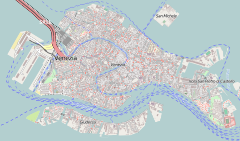History
By 1224, a hospital for lepers, dedicated to St Lazarus, patron saint of those afflicted with the disease, was found adjacent to the church of San Trovaso in the sestiere of Dorsoduro. In 1262, a Leper Colony was quarantined to an island in the Lagoon, then called Isola di San Lazzaro.

Leprosy, also known as Hansen's disease (HD), is a long-term infection by the bacteria Mycobacterium leprae or Mycobacterium lepromatosis. Initially, a person who is infected does not have symptoms and typically remains this way for 5 to 20 years. Infection can lead to granulomas of the nerves, respiratory tract, skin, and eyes. This may result in a lack of ability to feel pain, which can lead to the loss of parts of extremities from repeated injuries or infection due to unnoticed wounds. Weakness and poor eyesight may also be present.
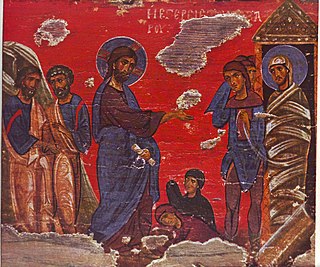
Lazarus of Bethany, also known as Saint Lazarus or Lazarus of the Four Days, venerated in the Orthodox Church as (Righteous) Lazarus the Four Days Dead, is the subject of a prominent miracle of Jesus in the Gospel of John, in which Jesus restores him to life four days after his death. The Eastern Orthodox and Roman Catholic traditions offer varying accounts of the later events of his life.
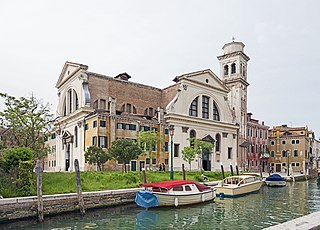
San Trovaso is a church in the sestiere or neighborhood of Dorsoduro in Venice, northern Italy.
In 1500, funds left over after the construction of the Basilica of Santi Giovanni e Paolo, were allocated to build an adjacent leper Hospital of San Lazaro, Ospedale di San Lazaro e dei Mendicanti. It was one of the four main hospitals (Ospedali Grandi) in Venice. The term Mendicanti could be derived from two sources: first in 1601, the Mendicant Friars commissioned building of this church from the architect Vincenzo Scamozzi. Second, the hospital appears to have served as a shelter for beggars (mendicanti), as well as lepers.

The Basilica di San Giovanni e Paolo, known in Venetian as San Zanipolo, is a church in the Castello sestiere of Venice, Italy.
The four great Venetian Ospedali - the Ospedale della Pietà, the Ospedale degl'Incurabili, the Ospedale di Santa Maria dei Derelitti, and the Ospedale di San Lazzaro dei Mendicanti - were charitable hospices, which provided a wide range of services for the needy of Venice. They are most famously recognized for educating select female pupils to professional levels of musicianship and attracting many European tourists to hear their all-female ensembles perform religious services and special concerts throughout the seventeenth and eighteenth centuries. The musical training in the Ospedali Grandi is often thought of as a precursor to the training in European conservatories of the 19th century.

Vincenzo Scamozzi was an Italian architect and a writer on architecture, active mainly in Vicenza and Republic of Venice area in the second half of the 16th century. He was perhaps the most important figure there between Andrea Palladio, whose unfinished projects he inherited at Palladio's death in 1580, and Baldassarre Longhena, Scamozzi's only pupil.
The father of Antonio Vivaldi taught violin at the music school here from 1689 to 1693. Like the Ospedale della Pietà, it took in abandoned girls who studied music and were trained to sing and play. The church still has a metal grille behind which the orphan girls (figlie del coro in Italian) sang.
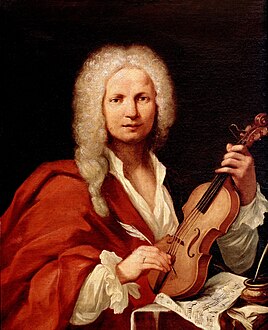
Antonio Lucio Vivaldi was an Italian Baroque musical composer, virtuoso violinist, teacher, and priest. Born in Venice, the capital of the Venetian Republic, he is regarded as one of the greatest Baroque composers, and his influence during his lifetime was widespread across Europe. He composed many instrumental concertos, for the violin and a variety of other instruments, as well as sacred choral works and more than forty operas. His best-known work is a series of violin concertos known as the Four Seasons.

The Ospedale della Pietà was a convent, orphanage, and music school in Venice. Like other Venetian ospedali, the Pietà was first established as a hospice for the needy. A group of Venetian nuns, called the Consorelle di Santa Maria dell’Umiltà, established this charitable institution for orphans and abandoned girls in the fourteenth century. By the seventeenth and eighteenth centuries the Pietà - along with the three other charitable Ospedali Grandi - was well known for its all-female musical ensembles that attracted tourists and patrons from around Europe.
For this church, the composer Simon Mayr wrote the oratorios Sisara (based on story of Sisera 1793), Tobiae matrimonium (1794) and David in spelunca Engaddi (1795).

Johann(es) Simon Mayr, also known in Italian as Giovanni Simone Mayr or Simone Mayr, was a German composer.
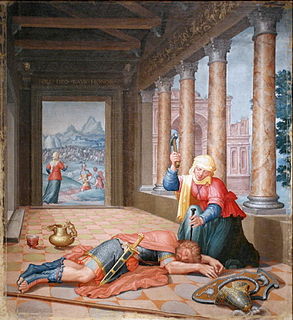
Sisera was commander of the Canaanite army of King Jabin of Hazor, who is mentioned in Judges 4-5 of the Hebrew Bible. After being defeated by the forces of the Israelite tribes of Zebulun and Naphtali under the command of Barak and Deborah, Sisera was killed by Jael, who hammered a tent peg into his temple.
Tobiae matrimonium, actio sacra pro filiabus chori S. Lazari is a 1794 oratorio by Simon Mayr to a Latin libretto by Giuseppe Maria Foppa. It was the third of Mayr's works written for the Ospedale dei Mendicanti. No exact date or circumstances for the original performance are known.
Description
Completed by 1631, the nave has no flanking aisles, but does have choir galleries. Scamozzi also designed the cloister of the adjacent hospital. The canal-facing facade, designed by Antonio Sardi, was not completed until 1673 by his son Giuseppe. The south side of the bell-tower has a sundial.
In the interior, the right wall, is a Crucifixion and Virgin and St John by Veronese, and in the second altar is a Saint Ursula and the 11 thousand Virgins by Tintoretto. The church contains the ornate funeral monument, completed by Sardi, and dedicated to the condottiero Alvise Mocenigo, represented as the admiral who died defending the then-Venetian Candia (Crete) from the Ottomans in 1654. Other funeral monuments were designed by Baldassare Longhena. The church also has a funeral monument for a member of the Rezzonico family. The interior decoration (1634–37) was designed by Francesco Contin.

The Basilica di Santa Maria Gloriosa dei Frari, usually just called the Frari, is a church located in the Campo dei Frari at the heart of the San Polo district of Venice, Italy. One of the most prominent churches in the city, it has the status of a minor basilica. The church is dedicated to the Assumption of Mary.

The Chiesa di San Nicolò da Tolentino, commonly known as the Tolentini, is a church in the sestiere of Santa Croce in Venice, northern Italy. It lies in a Campo of the same name and along the Rio dei Tolentini, near the Giardino Papadopoli.
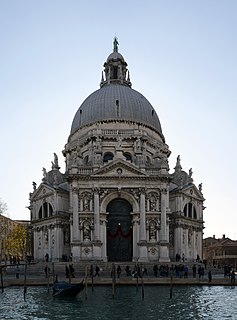
Santa Maria della Salute, commonly known simply as the Salute, is a Roman Catholic church and minor basilica located at Punta della Dogana in the Dorsoduro sestiere of the city of Venice, Italy.
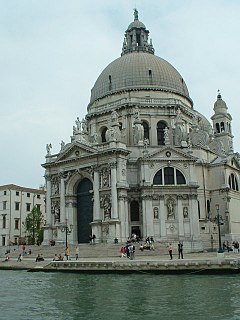
Baldassare Longhena was an Italian architect, who worked mainly in Venice, where he was one of the greatest exponents of Baroque architecture of the period.

San Francesco a Ripa is a church in Rome, Italy. It is dedicated to Francis of Assisi who once stayed at the adjacent convent. The term Ripa refers to the nearby riverbank of the Tiber.

San Francesco della Vigna is a Roman Catholic church in the Sestiere of Castello in Venice, northern Italy.

Santa Maria dei Carmini, also called Santa Maria del Carmelo and commonly known simply as the Carmini, is a large Roman Catholic church in the sestiere, or neighbourhood, of Dorsoduro in Venice, northern Italy. It nestles against the former Scuola Grande di Santa Maria del Carmelo, also known as the Scuola dei Carmini. This charitable confraternity was officially founded in 1597, and arose from a lay women's charitable association, the Pinzocchere dei Carmini. The members of this lay group were associated as tertiaries to the neighbouring Carmelite monastery. They were responsible for stitching the scapulars for the Carmelites.
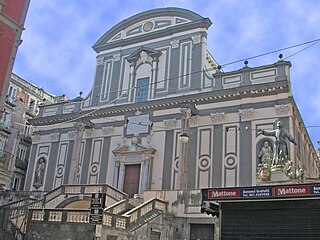
San Paolo Maggiore is a basilica church in Naples, southern Italy, and the burial place of Gaetano Thiene, known as Saint Cajetan, founder of the Order of Clerics Regular. It is located on Piazza Gaetano, about 1-2 blocks north of Via dei Tribunali.
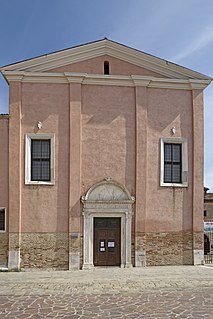
The Church of St Job is a 15th-century Roman Catholic church located overlooking the campo of the same name, known as Sant'Agiopo in Venetian dialect, on the south bank of the Cannaregio canal near Ponte dei Tre Archi in the sestiere of Cannaregio of Venice, northern Italy,

The Chiesa della Santissima Trinità dei Pellegrini is a church in the historic city centre of Rome. In the Regola rione, it neighbours other important historic buildings such as the Palazzo Farnese, Palazzo Spada, Ponte Sisto and the Via Giulia.

Francesco Contin was a Swiss-Italian sculptor and architect.
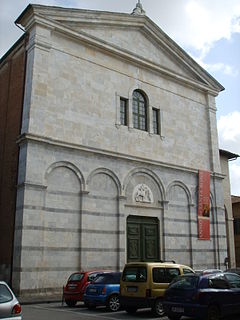
San Martino is a Roman Catholic church in Pisa, region of Tuscany, Italy, facing piazza San Martino, on the left bank of the Arno river.

San Tomà is a church which is located in the sestiere of San Polo in Venice, Italy. It stands opposite the Scoletta dei Calegheri.

Santa Fosca is a church in the sestiere of Cannaregio of Venezia, Italy. Adjacent to the Strada Nova, it faces the campo of Santa Fosca. On this campo stands the monument with a bronze statue of Paolo Sarpi.

The church of Santa Maria della Pietà or della Visitazione is a prominent church in the sestiere of Castello in Venice, Italy. It is sited on the Riva degli Schiavoni, a short walk from the Doge's Palace.

The Ospedale degli Incurabili is a large sixteenth-century hospital building on the Fondamenta delle Zattere, in the sestiere of Dorsoduro, in Venice in north-eastern Italy. Today it is occupied by the Accademia di Belle Arti di Venezia. It was built in the second half of the sixteenth century; the church – which no longer exists – may have been designed by Jacopo Sansovino.
This page is based on this
Wikipedia article Text is available under the
CC BY-SA 4.0 license; additional terms may apply.
Images, videos and audio are available under their respective licenses.




